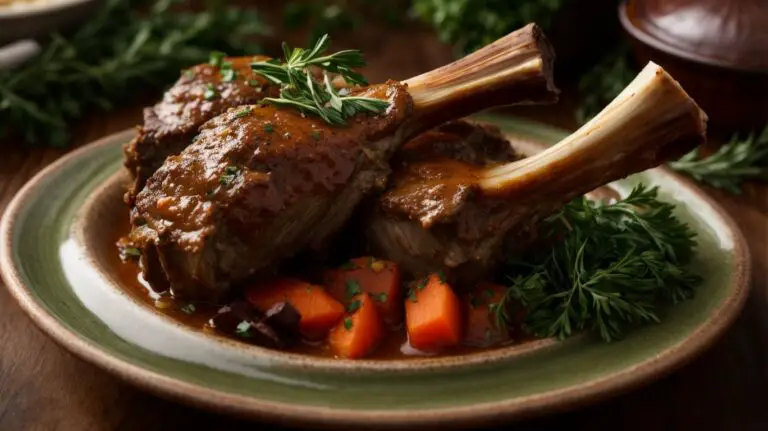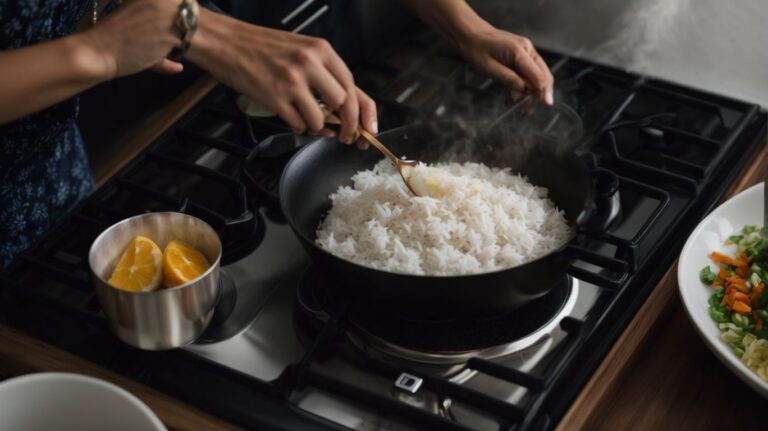How to Cook Kimchi Soup With Kimchi?
Are you a fan of Korean cuisine or looking to try something new in the kitchen?
In this article, we will explore the world of kimchi and its delicious counterpart, kimchi soup.
From the ingredients used to the nutritional benefits, we will cover everything you need to know about these flavorful dishes.
Get ready as we walk you through how to make kimchi soup step by step and provide you with some handy tips for cooking and storing this tasty dish. Let’s get cooking!
Key Takeaways:
What is Kimchi?
Kimchi, a staple in Korean cuisine, is a fermented dish made primarily from cabbage, radish, and a blend of seasonings like chili powder, garlic, ginger, and fish sauce.
Traditionally, the ingredients are fermented together in large jars, allowing the flavors to develop over time. The fermentation process breaks down the vegetables, creating a unique tangy and spicy taste. Kimchi is not just a side dish in Korean meals; it holds cultural significance and is often considered a symbol of Korean identity. Its popularity has spread globally due to its health benefits, such as being rich in probiotics and antioxidants. This dish adds a burst of flavor and nutrition to any meal, making it a favorite among food enthusiasts worldwide.
What Are the Ingredients of Kimchi?
Kimchi is typically made with ingredients such as Napa cabbage, radish, fish sauce, garlic, ginger, and chili powder, creating a harmonious blend of flavors and textures.
The primary ingredients in kimchi play crucial roles in its unique taste and fermentation process. Napa cabbage, the main component, provides a refreshing crunch and acts as the base for the dish. Radish adds a subtle sweetness while balancing the overall flavor profile.
Garlic and ginger introduce aromatic depth, enhancing the umami notes present in kimchi. Fish sauce contributes savory richness, while chili powder infuses heat and complexity, giving kimchi its signature spicy kick.
What Are the Nutritional Benefits of Kimchi?
Kimchi offers a range of nutritional benefits due to its fermentation process, providing probiotics for gut health, vitamins, and antioxidants from the vegetables used in its preparation.
Probiotics found in kimchi are beneficial for maintaining a healthy balance of gut bacteria, which can support digestion and overall immune function. The vitamin composition of kimchi, including vitamins A and C, can help boost the body’s immune system and promote healthy skin. Kimchi’s antioxidant properties help combat oxidative stress, reducing inflammation and lowering the risk of chronic diseases.
What is Kimchi Soup?
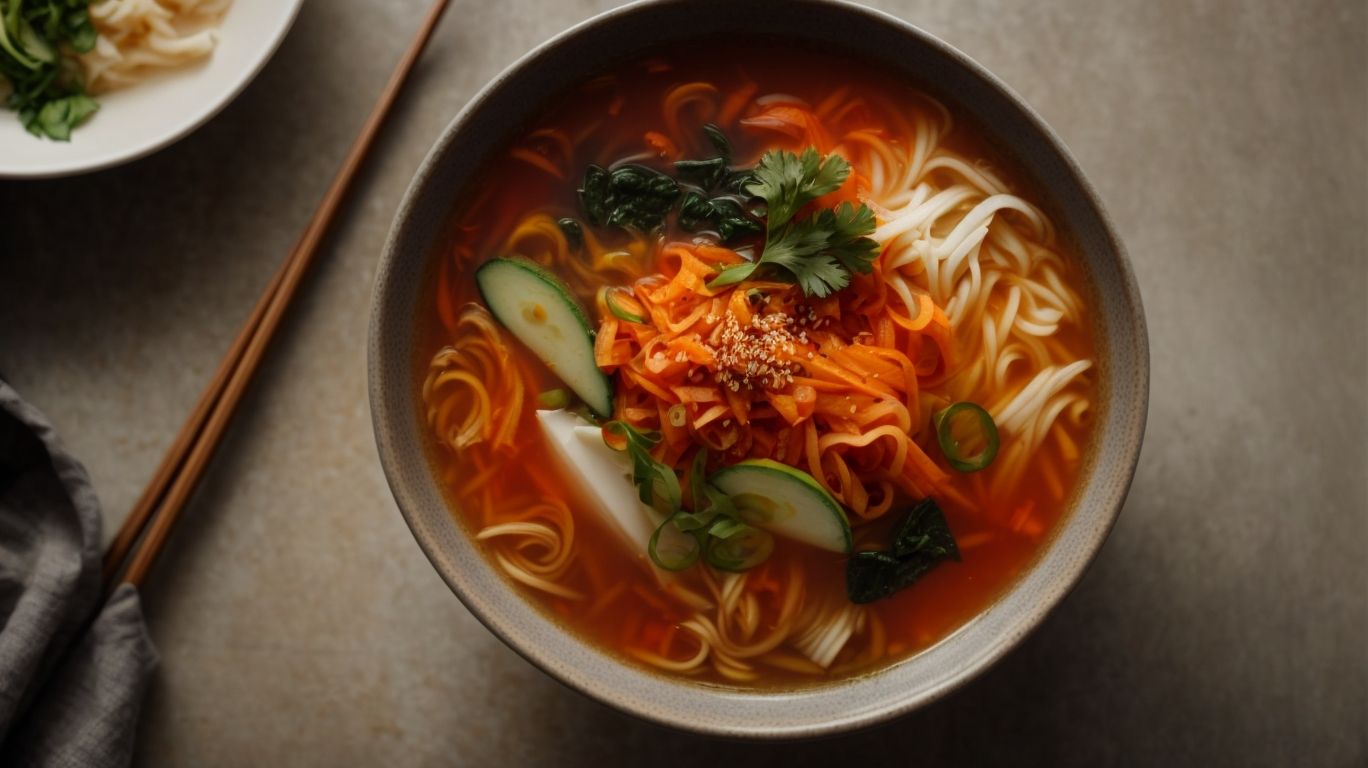
Credits: Poormet.Com – Arthur Martinez
Kimchi soup, known as Kimchi jjigae in Korean, is a popular stew that combines the flavors of kimchi, tofu, and often pork or seafood in a rich and spicy broth.
This traditional Korean dish is famed for its robust and complex flavors, with the fermented kimchi giving it a tangy kick while the soft tofu adds a contrasting creamy texture. The inclusion of kimchi is not only for taste but also brings a host of potential health benefits due to its probiotic nature.
Whether simmered with tender pieces of pork or the brininess of seafood, Kimchi soup remains a comforting and satisfying choice for those seeking a hearty meal with a touch of spice.
What Are the Ingredients of Kimchi Soup?
Kimchi soup typically contains kimchi, extra firm tofu, pork belly or seafood, and a spicy broth base enriched with flavors like garlic, ginger, and soy sauce.
Kimchi, being the star of the soup, adds its signature tangy and spicy flavor profile, alongside contributing its beneficial probiotics.
The extra firm tofu, known for its ability to absorb flavors, provides a textural contrast to the crunchy kimchi.
Pork belly or seafood not only offers protein but also infuses richness into the broth, elevating the overall taste.
The garlic and ginger enhance the depth of the soup with their aromatic warmth, while the soy sauce adds a savory umami essence that ties all the flavors together harmoniously.
What Are the Health Benefits of Kimchi Soup?
Kimchi soup offers various health benefits, with tofu providing protein, the spicy broth aiding digestion, and the kimchi contributing probiotics and vitamins.
Along with being a delicious and comforting dish, consuming kimchi soup can have a positive impact on one’s overall well-being. Tofu, a staple ingredient in this hearty soup, is an excellent source of plant-based protein, essential for muscle repair and growth. The spicy broth not only adds a flavorful kick but also assists in digestion, helping to alleviate bloating and indigestion. The star ingredient, kimchi, is packed with beneficial probiotics that support gut health and boost the immune system, while also providing a substantial dose of essential vitamins like A and C.
How to Make Kimchi Soup?
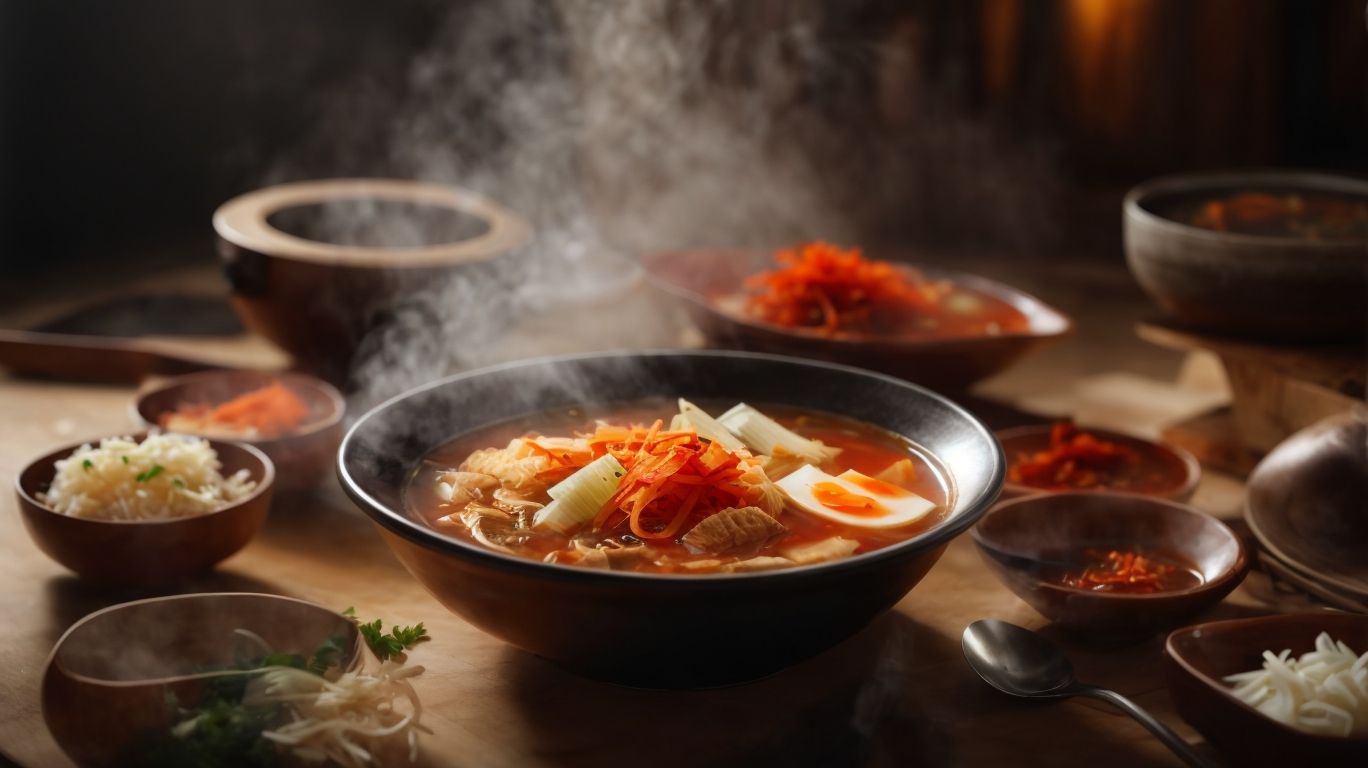
Credits: Poormet.Com – Willie Lewis
Making Kimchi Soup involves preparing the kimchi, creating a flavorful broth, adding the kimchi and other key ingredients, and simmering the stew to meld the flavors together.
Begin by selecting high-quality kimchi that is fermented to perfection, as this is the key ingredient that will infuse the soup with its signature tangy and spicy flavors. Next, chop the kimchi into bite-sized pieces to ensure each spoonful of the soup is bursting with that distinct kimchi taste.
- For the flavorful broth, start by sautéing aromatics like garlic, ginger, and onions in a pot until fragrant, building a solid base for the soup.
- Add vegetable or chicken broth to the pot and bring it to a gentle simmer, allowing the flavors to marry together.
- Then, introduce the chopped kimchi into the broth, along with any additional vegetables like tofu, mushrooms, and greens, enhancing the texture and depth of the soup.
- Let the soup simmer on low heat, allowing all the ingredients to mingle and develop a rich, complex flavor profile. This step is crucial for achieving that perfect balance of sweet, spicy, and savory notes.
Step 1: Prepare the Kimchi
To start making Kimchi Soup, prepare the kimchi by fermenting Napa cabbage, radish, and a mix of seasonings like chili powder, garlic, and ginger.
After the vegetables have been properly fermented, the next step in preparing the kimchi soup involves selecting the other key ingredients such as tofu, mushrooms, and green onions to enhance the flavors and textures of the dish. These additional components complement the tangy and spicy notes of the fermented kimchi, resulting in a harmonious balance of flavors. To intensify the umami taste, you can also consider adding some soy sauce or fish sauce to the preparation.
Step 2: Prepare the Broth
Next, prepare the broth for Kimchi Soup by simmering garlic, ginger, and other aromatics in a spicy base to infuse the soup with rich flavors.
As the garlic and ginger release their enticing aroma, the broth becomes infused with a depth of flavor that forms the foundation of the dish. The gentle simmering process allows the flavors to meld together harmoniously, creating a robust and aromatic base.
The use of other aromatics such as leeks, scallions, and star anise further enhances the complexity of the broth, adding layers of savory goodness.
Each ingredient plays a crucial role in building a broth that is not only flavorful but also deeply satisfying, setting the stage for the final assembly of the hearty Kimchi Soup.
Step 3: Add the Kimchi and Other Ingredients
Add the prepared kimchi, tofu, and choice of protein like pork belly or seafood to the simmering broth, allowing the flavors to meld and the ingredients to cook together.
As the kimchi, a staple in Korean cuisine known for its fermented spicy flavors, starts to infuse the broth with its distinct tanginess, the tofu gently absorbs the rich broth, adding a creamy texture to the dish. The choice of protein, such as succulent pork belly or fresh seafood, brings a hearty element to the soup, as the meat simmers and releases its savory juices into the bubbling concoction. Each ingredient plays a crucial role in creating a harmonious blend of flavors, ensuring a satisfying and nourishing meal.
Step 4: Simmer and Serve
Let the Kimchi Soup simmer gently to allow the flavors to meld, then serve the steaming stew garnished with shredded green onions, sesame seeds, and a drizzle of sesame oil.
As the Kimchi Soup simmers, the aroma intensifies, filling the kitchen with a tantalizing smell that whets the appetite. Once the stew reaches its perfect consistency, it’s time for the final touches. Sprinkle a generous amount of fresh, vibrant green onions on top of the steaming soup, adding a pop of color and a refreshing crunch.
Next, scatter a handful of nutty, toasted sesame seeds over the surface, imparting a rich, earthy flavor and a delightful texture to each spoonful. Finish the dish with a subtle drizzle of fragrant sesame oil that enhances the overall taste profile and adds a glossy sheen to the soup.
Tips for Cooking Kimchi Soup
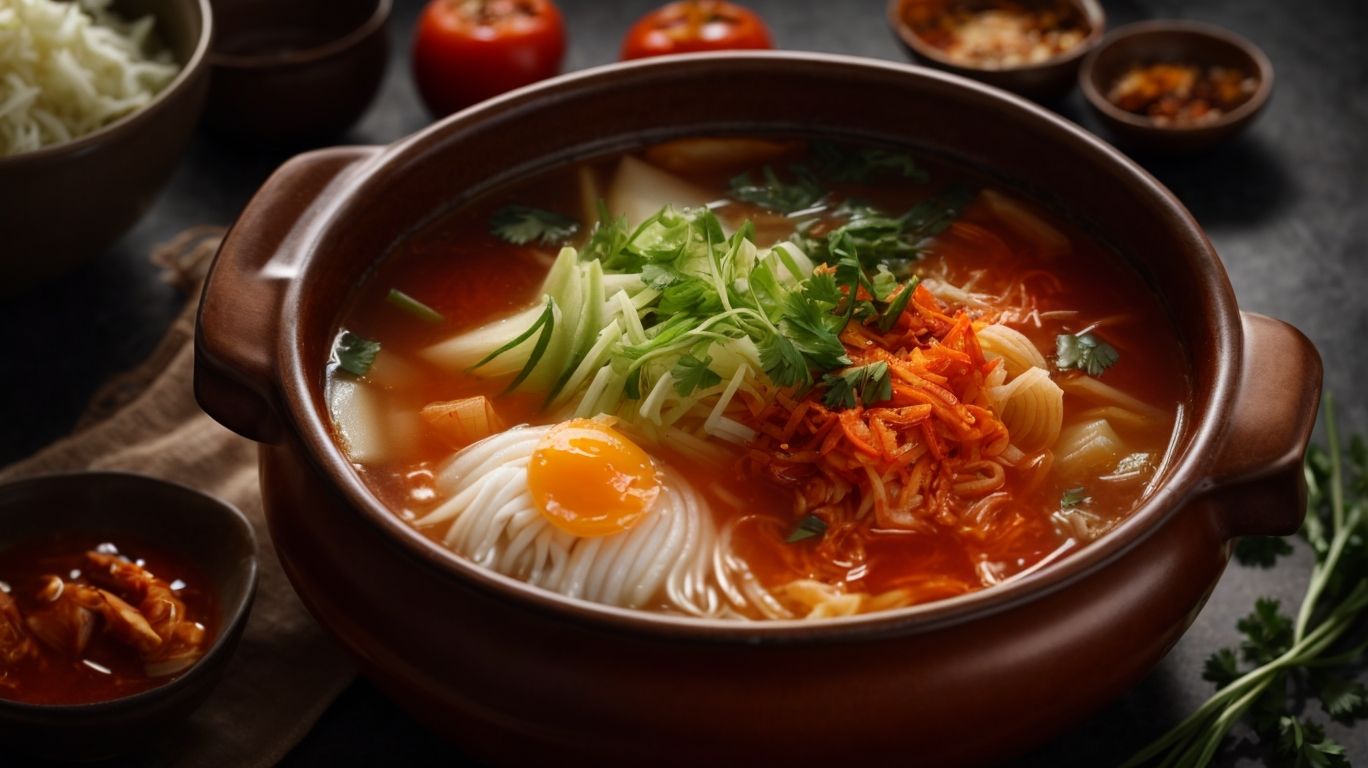
Credits: Poormet.Com – Bobby Harris
Enhance your Kimchi Soup experience by adjusting the spice level to suit your taste preferences and learning how to store leftover soup for future enjoyment.
To customize the spice level of your Kimchi Soup, start by adding fewer or more red pepper flakes based on your heat tolerance. You can also balance the spiciness by incorporating additional sugar or vinegar. For a milder option, opt for less fermented kimchi or utilize a vegetable broth as the base.
When storing leftover soup, ensure it is cooled to room temperature before refrigerating it in an airtight container for up to 3-4 days. To enhance your overall dining experience, consider serving the soup with a side of steamed rice or crispy tofu, adding depth to the meal.
How to Adjust the Spice Level?
To modify the spice level of Kimchi Soup, consider using ingredients like shoyu for a savory touch or adding tenderloin for a richer flavor profile.
Another way to adjust the spiciness of Kimchi Soup is by incorporating different types of chili peppers, such as gochugaru for a milder heat or gochujang for a spicier kick.
You can also balance out the spice by adding coconut milk for a creamier texture and a hint of sweetness, which can help mellow down the intensity of the dish.
For those looking to increase the heat, consider adding some freshly sliced jalapeños or Thai bird’s eye chilies to the soup for an extra fiery element.
How to Store Leftover Kimchi Soup?
For storing leftover Kimchi Soup, transfer it to an airtight container and refrigerate, or utilize a rice-cooker with added anchovy stock to create a flavorful rice soup the next day.
If you opt for refrigeration, ensure that the lid of the airtight container is tightly sealed to maintain the freshness of the Kimchi Soup. It’s recommended to consume the refrigerated leftovers within 2-3 days for the best quality.
On the other hand, repurposing the leftover Kimchi Soup into a rice soup is a delightful way to enjoy a new dish. Simply add the leftover soup, along with some cooked rice, to a rice-cooker. Pour in some homemade or store-bought anchovy stock to enhance the flavors and let it cook until the rice is perfectly infused with the soup. This transformation not only reduces waste but also creates a comforting and satisfying meal for another day. Make sure to adjust the seasoning if needed before serving the revitalized rice soup.
Conclusion
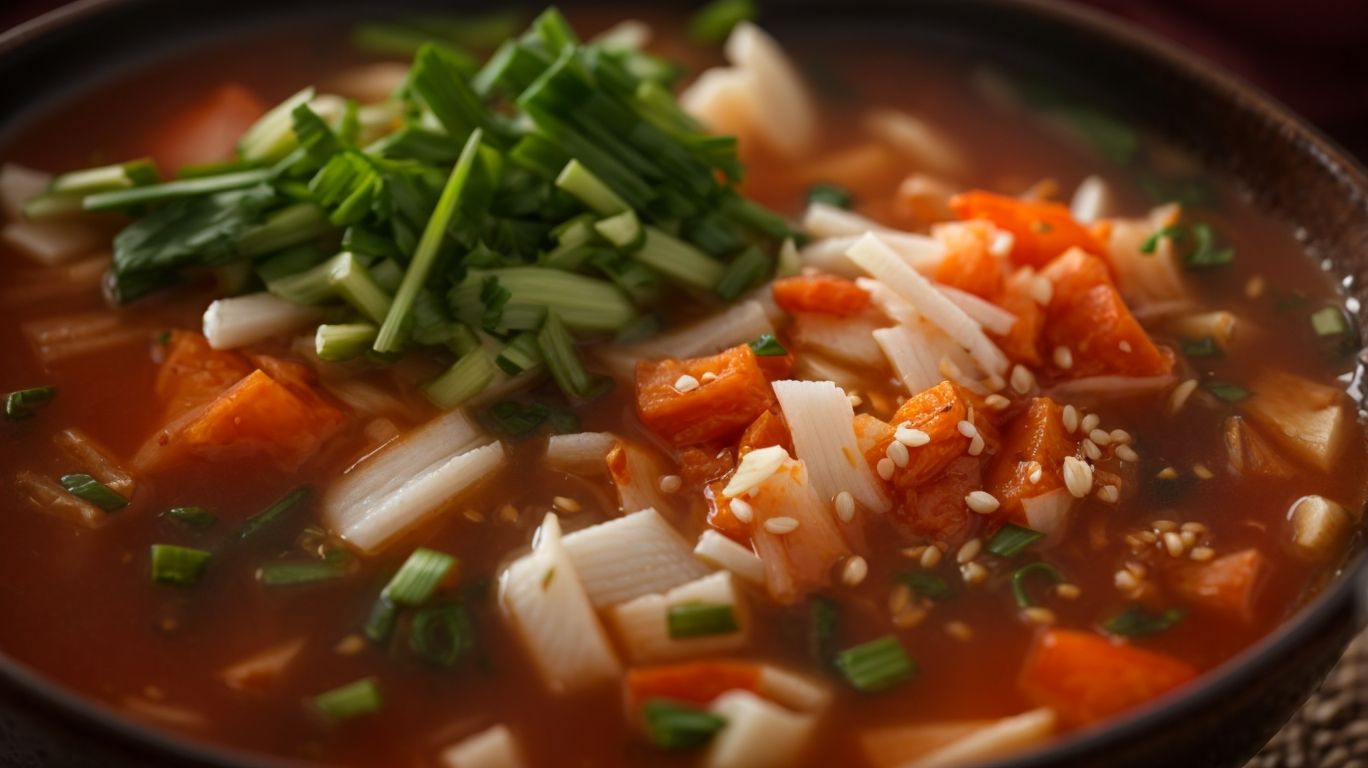
Credits: Poormet.Com – Thomas Lewis
In conclusion, Kimchi Soup stands as a flavorful and nutritious dish that encapsulates the essence of Korean cuisine, offering a balanced blend of flavors and health advantages.
Originating from the traditional process of fermenting Kimchi, this soup highlights the bold and tangy flavors synonymous with Korean dishes. With its base often made of hearty vegetables, spicy Kimchi, and savory broth, it delivers a unique umami taste that tantalizes the taste buds. Rich in probiotics and packed with vitamins and antioxidants, Kimchi Soup not only satisfies cravings but also aids digestion and boosts the immune system, making it a staple in Korean culinary traditions.
Frequently Asked Questions
How to Cook Kimchi Soup With Kimchi?
What ingredients do I need to make kimchi soup with kimchi?
You will need kimchi, pork or beef, tofu, onion, garlic, gochujang, and sesame oil.
How to Cook Kimchi Soup With Kimchi?
Can I use any type of meat in kimchi soup?
Yes, you can use any type of meat, such as pork, beef, chicken, or seafood. However, pork and beef are the most common choices.
How to Cook Kimchi Soup With Kimchi?
How do I prepare the kimchi before adding it to the soup?
You can chop the kimchi into small pieces or leave it in larger chunks, depending on your preference. If the kimchi is too sour, you can rinse it with water before using it in the soup.
How to Cook Kimchi Soup With Kimchi?
Do I need any special equipment to make kimchi soup?
No, you can make kimchi soup with just a pot or a large saucepan. However, a rice cooker can also be used to make the soup.
How to Cook Kimchi Soup With Kimchi?
Can I add other vegetables to my kimchi soup?
Yes, you can add other vegetables like mushrooms, carrots, or zucchini to the soup. Just make sure to adjust the cooking time accordingly.
How to Cook Kimchi Soup With Kimchi?
How long will kimchi soup last in the fridge?
Kimchi soup can last for 3-4 days in the fridge if stored properly in an airtight container. You can also freeze it for longer storage.


